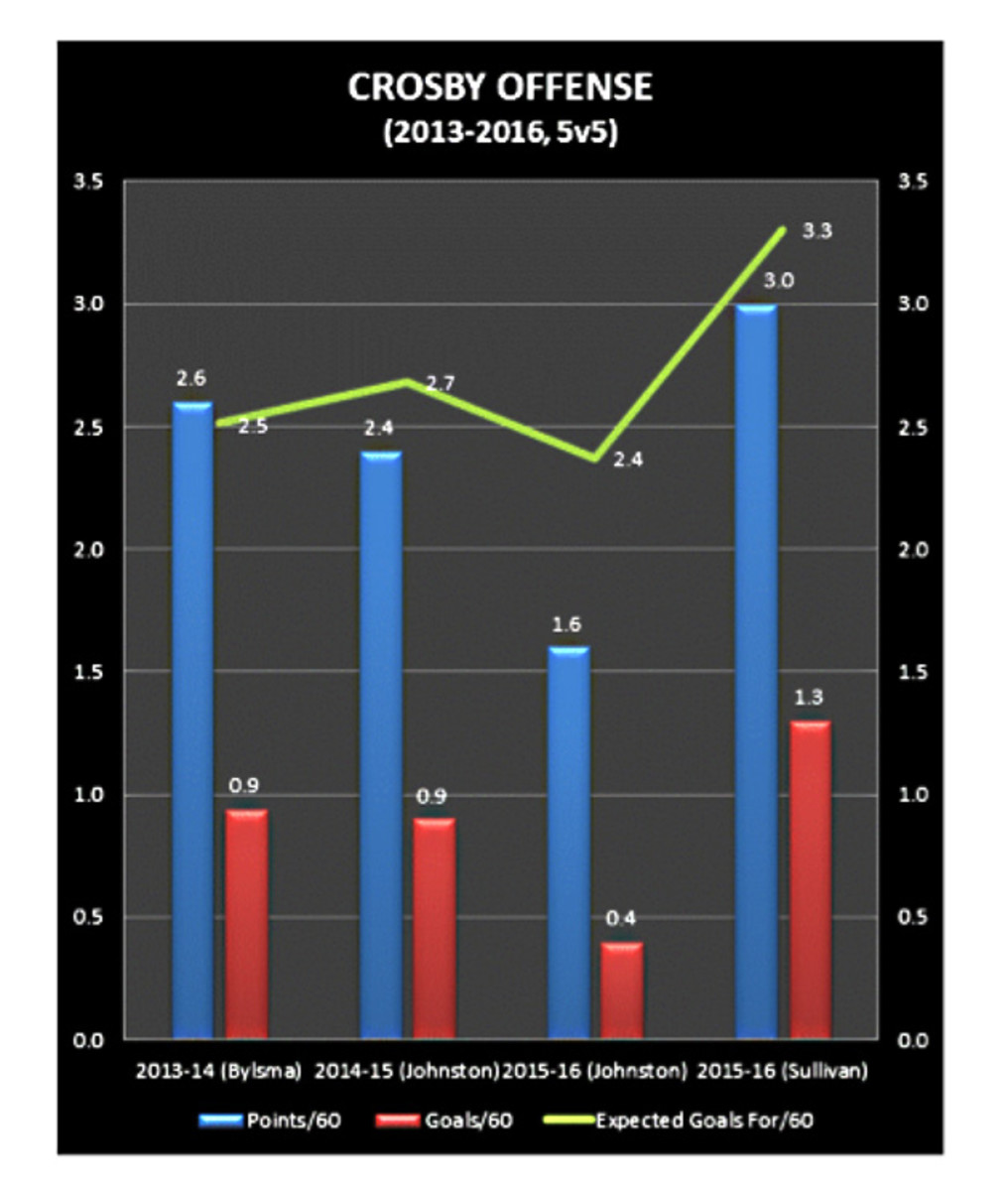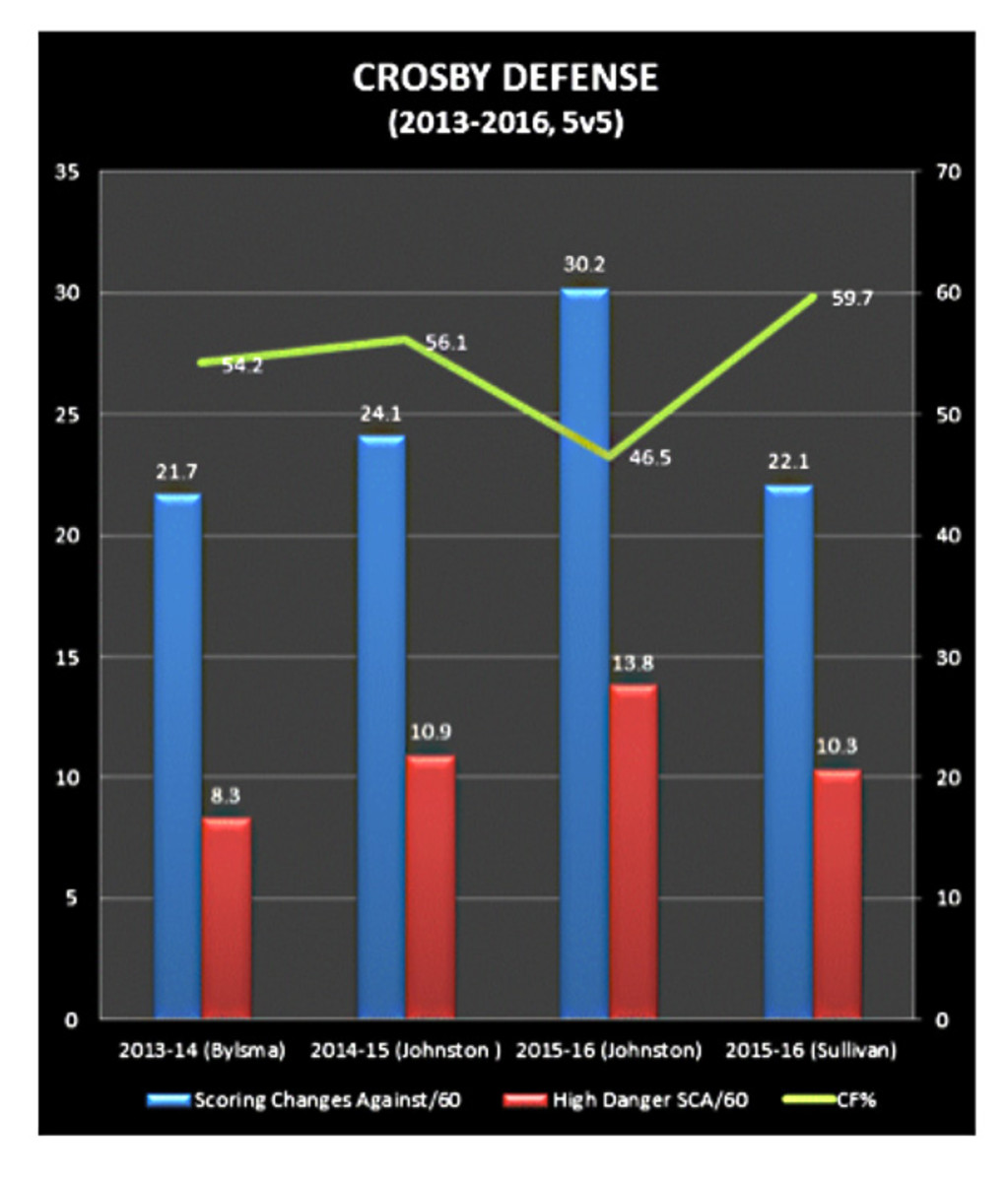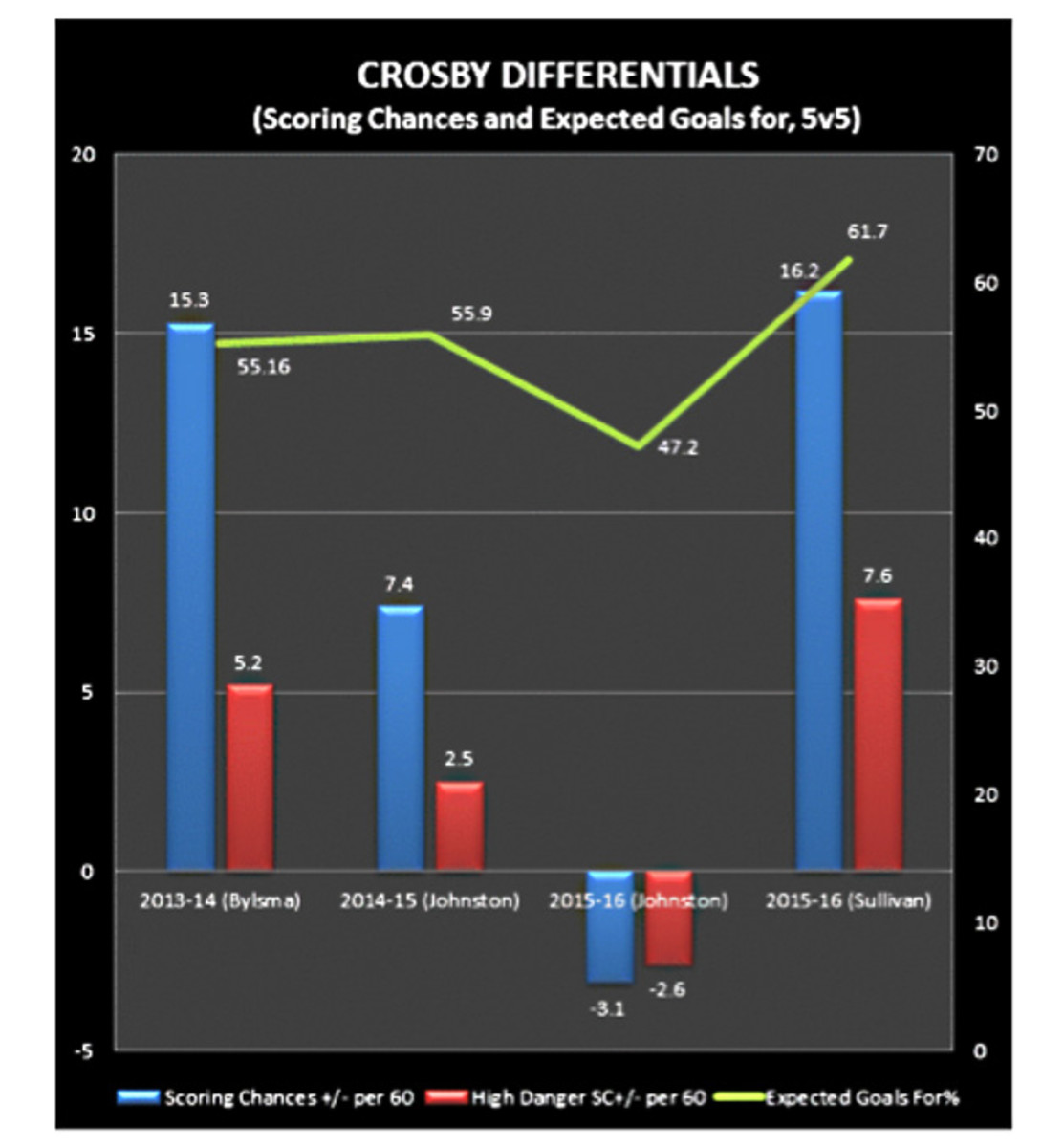The key to Sidney Crosby's resurgence

After a brutal start to the season for the best forward on the planet, there’s no doubt that Sidney Crosby is back on track. That he’s playing much better is hardly news. But what many people don’t fully appreciate is that Sid the Kid didn’t “round back into form” or gradually “turn his game around.” It’s more like somebody flipped a switch.
That switch was flipped on December 12, and that somebody was the Penguins’ new coach, Mike Sullivan.
Earlier this year we wrote about how James Van Riemsdyk’s productivity was transformed under new Maple Leafs coach Mike Babcock. The same seems to have happened to Crosby under Sullivan.
How an NHL team’s system affects a player’s performance
Coming into the season the Penguins were on the short list of teams to come out of the Eastern Conference. After making a big splash by trading for supremely skilled, if enigmatically fitness-challenged, former Maple Leafs sniper Phil Kessel, the Penguins were poised to have a big year. Now that the team had finally given Crosby the type of top-tier winger that pretty much everyone agreed might take his game to even greater heights, it looked like both Sid and the Pens were ready for their best campaign since they won the Stanley Cup in 2009.
That’s not exactly how things worked out. On December 12 the Penguins were 28 games into the season. Their record was 15-10-3, good for only fourth in the Metropolitan Division, and one point out of playoff position. On an individual level, Crosby was struggling through the worst start of his career, with only six goals and 13 assists. His 2.0 points per 60 minutes (in all situations) was well under his career average of 3.82.
Even though he was only 28 years old, many commentators were starting to seriously question whether Crosby would ever be able to regain his old form. Not only was he not producing, he just didn’t seem like his old self.
The hallmarks of Crosby’s offensive game have always been rushing the puck into the offensive zone and holding off defenders down low until he finds an opening to make pinpoint passes to linemates who are camped in front of the net. At the beginning of this season Crosby wasn’t doing much of any of those things. Instead of carrying the puck, he seemed to be dumping it in or forcing errant passes, and his low cycle game seemed to have all but disappeared.
The SI Extra Newsletter Get the best of Sports Illustrated delivered right to your inbox
Subscribe
Unlike most of the league’s historic scoring heroes, Crosby has been at least equal parts power forward and elite finesse player. His slow start had commentators wondering whether all the hard minutes he had played, plus his concussion and other injuries, were finally catching up to him. As shown in the graph below, his goals and points per 60 minutes (5v5) declined slightly from his 2013-14 season under coach Dan Bylsma through the 2014-15 season under Mike Johnston, before falling off a cliff through the first 28 games of this season.
Now, 27 games later, no one’s wondering about him any longer. As of Feb. 18, Crosby stood eighth in the league in scoring with 24 goals, 29 assists and 53 points. Since the Pens replaced Johnston with Sullivan, Crosby’s 5v5 point production has almost doubled (to 3.0 per 60 minutes, good for third in the NHL since December 12) and his goal production has more than tripled (to 1.3 per 60 minutes).
Crosby’s “expected” goals-for—represented by the green line on the first graph below—shows a similar spike. Expected goals–for is a new metric that serves a similar function to the more widely-known Corsi (i.e., shot attempt) stat. It attempts to provide a broad measure of performance that adjusts for the randomness or “puck luck” that can distort goal or point totals in smaller samples. Expected goals-for accomplishes this by taking into account both the number of shot attempts and a rough estimation of shot quality. Although it’s far from perfect, it does appear to be a more accurate statistic than Corsi and others that rely exclusively on the volumes of shot attempts without any consideration of shot quality.

* Expected goals for courtesy of xtrahockeystats.com
** All stats other than Expected Goals-For /60 courtesy of war-on-ice.com.
Generating more offense often comes with the expense of giving up more shots or scoring chances in the defensive end. Not for Sid. The next graph illustrates an improvement in defensive metrics (5v5) that’s almost as impressive as the improvement in Crosby’s offense. After his scoring chances-against and high danger scoring chances-against jumped from last season to the first half of this season, Crosby is back well below his career averages. At the same time, his Corsi For % (i.e., shot attempt differential) has increased more than 13 points to 59.7%, which, if maintained, would be the highest CF% of Crosby’s career.

As shown in the third graph, since December 12, in the aggregate, Crosby has increased his scoring chance differential by an almost impossible 19.3 per 60 minutes and his high danger scoring chance differential by 10.2 per 60 minutes. His expected goal differential increased by 14.5%.

This almost unheard of turnaround wasn’t a process. It wasn’t a matter of slowly tweaking a system to iron out wrinkles or optimize results. It wasn’t a matter of a player getting healthy after a nagging injury. It was a complete 180 degree turnaround from an accelerating slide that spanned at least the previous season and 28 games under coach Johnston. As illustrated by the next graph—which is one of many interesting new hockey stat visualizations that can be found at hockeyviz.com—it happened instantly, as soon as Mike Sullivan took the reins behind the Penguins’ bench.

The graph shows Crosby’s shot attempt differential on a game-by-game basis (though the results are “smoothed” to account for trends before and after individual games). Where the red line is above the black, and the shaded area in between is red, it indicates that when Crosby was on the ice his opponents were attempting more shots than the Penguins. Where the black line is above the red, and the area in between is grey, it indicates the opposite: that the Penguins were attempting more shots than their opponents. The unmistakable turnaround is at Game 28, when Sullivan replaced Johnston.
Hockey’s great shot volume debate
What changes did Sullivan make to get these results? As usual, the “why” is harder to figure than the “what.” But the eye test tells us that Crosby has gone back to his puck-carrying and “low-post” game. He seems to be playing with much more energy, maybe because he’s back to playing his old, incredibly successful style.
Another answer seems to be that Sullivan has re-established consistency in Crosby’s linemates, including reuniting him with his long-time winger Chris Kunitz. The following graph (also from hockeyviz.com) shows the 10 most common linemates Crosby has played with this season. Each narrow rectangle along the horizontal axis is one game, with the vertical colors denoting the number of minutes Crosby played with each linemate for that game. Before Game 28, we see that the season started with the failed Kessel experiment and then Johnston mixed and matched linemates for Crosby, including Pascal Dupuis, Patric Hornqvist, Kunitz, and Beau Bennett. After Game 28, Kunitz’s red line is a mainstay, with most of the other minutes going to Hornqvist.

Finally, Crosby’s improvement is almost certainly the result of at least a partial reversal of Mike Johnston’s over-emphasis on defense and protecting goaltender Marc-André Fleury at the expense of crippling the scoring productivity of the best offensive player of this generation. Johnston seems to have subscribed to the somewhat discredited cliché that “defense wins championships,” or at least he misapplied it. Maybe he should have gone with another adage instead, and realized that sometimes the best defense is a good offense—especially when the offense is spearheaded by Sidney Crosby.
Whatever Sullivan has done, it’s worked wonders. Chalk up another stark example of how a coaches’ system can radically impact a player’s performance.
The Department of Hockey Analytics employs advanced statistical methods and innovative approaches to better understand the game of hockey. Its three founders are Ian Cooper (@ian_doha), a lawyer, former player agent and Wharton Business School graduate; Dr. Phil Curry (@phil_doha), a professor of economics at the University of Waterloo; and IJay Palansky (@ijay_doha), a litigator at the law firm of Armstrong Teasdale, former high-stakes professional poker player, and Harvard Law School graduate. Visit us on line at www.depthockeyanalytics.com
